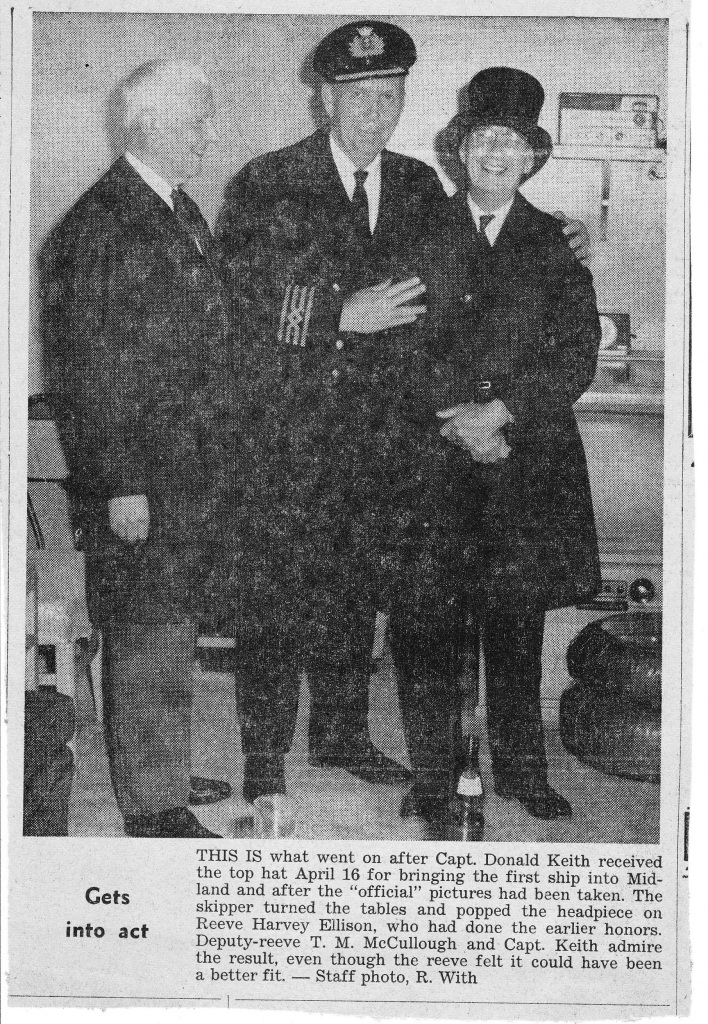Scattered settlers and early cottagers along the Georgian Bay shores relied upon small local steamboats for supplies and transportation during the navigation season. One of the year-round people was James Drummond, a widower who settled on a small mainland bay north of Honey Harbour in 1899.
He built a frame cottage and two stone barns on his land. At the water’s edge a stone pier jutted into deep water where inter-island vessels could dock.
Drummond wrested what produce he could grow from the meagre soil, kept some livestock, and subsisted by using his place as an unoffical store and meeting place for the summer community. Over the years his most substantial income probably came from the sale of his waterfront property to cottagers.
Drummond was one of a handful of settlers on the shore just after the turn of the last century. It was a lonely and hard existence, especially in winter when the elements isolated them from the outside world for lengthy periods. Perhaps it was lonelier in Drummond’s case because of a certain aloofness and independence the man had. Some even remembered him as hermit-like. But a weakling he was not.
It was in December, 1936, when Drummond was nearly 87, that he fell on the ice and broke his left hip. Alone, and with his left leg useless, he dragged himself to the door of his cottage with the full knowledge that this could be his end. But with a strong faith and an ingenuity born of 37 years on the shore, the old man kept both himself and his animals warm and fed for ten days until help arrived in the form of two younger men, Joe Corbiere and Jim Nicholson.
“Pluck is all a man needs at any time,” he remarked later when telling his story to a reporter.
Jim Drummond came to the shore from Prince Edward County after his wife died in 1881. He was granted his land under a government program encouraging settlement in the Muskoka region. As he established his backwoods farm with its sparse resources, Drummond’s eccentric personality was gradually revealed. His neighbours found some of his traits amusing and others very annoying.
He and a cohort took on a job of building a stone fireplace in a neighbour’s cottage. It would take two weeks, they said. Jim and his gray mare Queenie would collect stones while the other man would do the actual masonry.
The trouble was, instead of stabling Queenie in his barn overnight, Jim would let her wander free so she could graze from nature’s bounty off the land. Next morning the men might spend half the day searching for the mare to haul the stone-boat with rocks for the mason to do his work.
Instead of two weeks, the job took all summer. The cottage owner seethed in silent rage.
As cottages sprang up around the little bay, Drummond’s place became a sort of backup store for tourists who ran out of certain items that he might be able to provide. It was as hit-or-miss situation because Jim’s dependability was sometimes questionable.
However he saw an opportunity and was approved to operate an “account” post office, some sort of seasonal temporary service for the area.
One cottager who carried on a lot of correspondence during the summer, a Mrs. Plumtree, was skeptical of Drummond’s reliability and preferred to send her mail by boat directly to Penetanguishene. But to be fair she thought she would at least buy her stamps from him. So she sent a youngster over to Drummond’s to get some.
Certainly not, declared the indignant “account” postmaster. If Mrs, Plumtree wasn’t sending her mail through him she could not expect to buy her stamps there either!
In the long, dark evenings of the off-season Drummond eased the loneliness by reading books aloud, giving a different voice to each character in the story. A favourite was the Tarzan of the Jungle series. Apparently he continued entertaining himself this way into the summer, leading neighbours to think he had a crowd of visitors in his house.
Jim Drummond had a long white beard, probably somewhat discoloured in his final years. There was a family story of my parents paying him a visit, with June just a toddler, and their first dog, a terrier named Judy. June and Judy were fascinated with that beard. Judy so much so that she buried her nose in its delightful (to a dog) scents. The visiit was cut short to reduce embarrassment.





